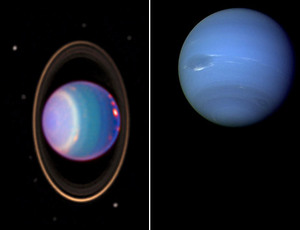Like children growing up and moving away from home, the gas giant planets of our solar system took shape twice as close to the sun as they are now and slowly moved outward.

|
| ©Uranus image courtesy NASA/Space Telescope Science Institute; Neptune image courtesy NASA/JPL
|
| The gas giant planets of our solar system took shape twice as close to the sun as they are now and slowly moved outward, according to a new theory that challenges established ideas for how the gas giants formed. But for this theory to work, the lead author says, Uranus (left) and Neptune (right) had to have switched orbital positions up to four billion years ago.
|
But the new theory of planetary formation, proposed by astrophysicist Steve Desch, only works if Uranus and Neptune swapped orbital positions up to four billion years ago.
Desch's work challenges the established theory that the gas giants formed from planetary materials that moved inward toward the sun.
Existing models have Uranus and Neptune taking billions of years to form. But chemical clues in their atmospheres mean that they didn't have that much time, said Desch, of Arizona State University.
"It's important to form those planets within ten million years, because that's how long hydrogen and helium gas remain in the early solar system," he said.
"Even Uranus and Neptune have a few Earth masses [worth] of these gases," which means they must have taken shape early while the gases were still available.
Proponents of longer-standing theories of solar-system formation say there's never been consensus about where the planets first took shape.
The new work, they say, fills in a piece of the story by accounting for the amount of material it would have taken to create them.
The research appeared in the December 10 issue of the
Astrophysical Journal.
Nice Model
Commonly accepted theory has it that the inner rocky planets, such as Earth and Mars, formed from collisions between larger objects. (Explore an
interactive solar system.)
But the formation of the gas giants - Jupiter, Saturn, Uranus, and Neptune - has remained puzzling to planetary scientists.
Desch's work builds on the so-called Nice model, a term coined in 2004 after scientists met in Nice, France, to deliberate the formation of the solar system.
Now that Pluto has been demoted, Neptune is the most distant planet from the sun, orbiting at a distance of about 2.8 billion miles (4.5 billion kilometers).
Uranus, at about 1.9 billion miles (3 billion kilometers) away from the sun, is the next most distant.
The Nice model suggests that Uranus and Neptune formed much closer to the sun, were pushed outward by the then-orbits of Jupiter and Saturn, and were nudged into their current positions by leftover materials from planet formation.
Alan Boss is a planetary scientist at the Carnegie Institution of Washington who was not involved in Desch's research.
He says the new work "helps fill in a piece of the puzzle, but it doesn't change the big picture."
The main contribution Desch has made, Boss said, is to propose that the protoplanetary disk leading to the formation of Uranus and Neptune was denser than scientists had previously believed.
"That makes the disk much more capable of making gas giant planets, which is positive," he said.
Desch's theory suggests that our dusty solar nebula was four to ten times denser than most models have predicted.
Based on the density of materials at their surfaces, Neptune would have needed to move past Uranus about 650 million years into the solar system's evolution.
"This is very strong circumstantial evidence that for the first 15 percent of the solar system's history, Neptune was closer to the sun than Uranus," Desch writes in his paper.
The Nice model gave that possibility a 50-50 chance.
Bottoms Up, Top Down
In addition to theories about where they formed, two main theories have been used to explain how the gas giants got their starts.
The core accretion theory, also called the "bottoms up" model, proposes that ice chunks collected to form cores substantial enough to produce gravity.
These cores then gathered up gases from the disk of protoplanetary material around the sun.
The other explanation is sometimes called the "top down" model, because it has the gas collecting first and acquiring enough mass to draw materials in to form a core.
But neither existing theory has pinned down exactly where the materials would have come from.
Desch points out that his theory still allows for the gas giants to have formed either by core accretion or disc collapse - it doesn't compete with either school of thought.
Overall, he said, his model is a surprisingly tight fit with today's solar system.
"I was startled by how smoothly the distribution of mass in the solar nebula conformed to a single, simple mathematical formula."
Reader Comments
to our Newsletter